Handling chinchillas needs to be done with care. These animals have very small bones and can be quite wiggly. When they wiggle, instinct is to tighten the hold on the chinchilla. This can cause injury to those tiny bones and also cause internal bleeding. Therefore it is necessary to learn how to hold and handle them properly. Proper handling does depend on the age and size of the chinchilla. Special ways of grabbing/securely holding a chinchilla that may seem cruel at first are actually quite easy on them and can actually save their lives. Additionally, the frequency with which a chinchilla is handled can affect how well they behave when held.
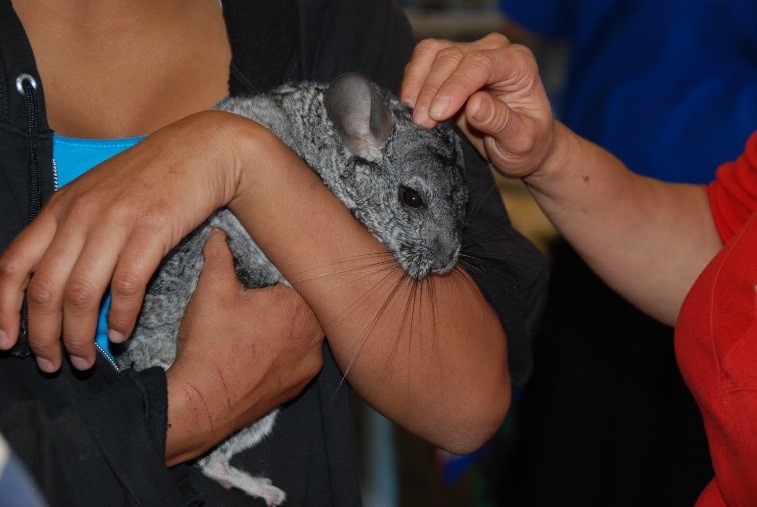
Adult chinchillas are usually calmer than babies and easier to catch and hold, especially if they are used to being handled. As long as all four feet are supported, they are often comfortable and will permit being held. One way to hold an adult is to allow him to sit with all four feet on one arm and hold gently across the shoulders or by the base of the tail with the other hand. This will help to keep the chinchilla from making a sudden jump out of the arms of the person holding it.
Another method of holding allows the chinchilla to place all four feet on the person’s chest and use the hands to hold gently across the back and again on the base of the tail. Some chinchillas actually like being turned around with their feet facing out but in the same position. It is believed that they like to be able to see what is going on. Once a chinchilla is used to being held by a person, other ways of holding such as sitting on the shoulder are possible.
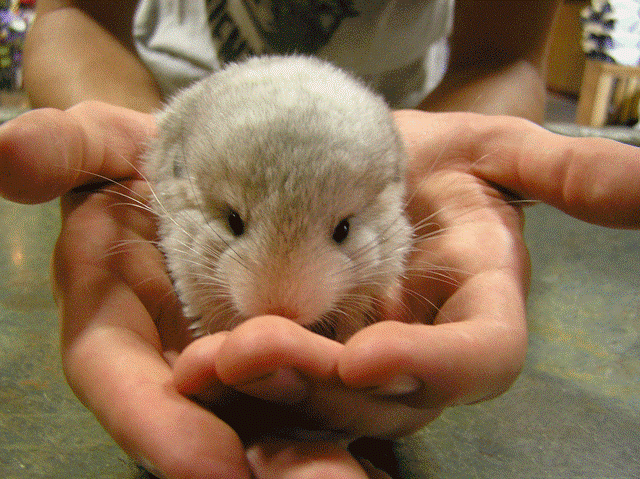
Babies need extra care when holding and handling. Since they are smaller, it is easier to hurt them accidentally. It is wisest to hold one baby (kit) at a time. Babies tend to make sudden rapid movements which are hard to predict and counteract because of their size. When more than one is being held, the problem just multiplies. Because of this, kits are often dropped. Falling from the height of just a few feet can kill a kit.
When holding a kit, use both hands. Place the baby in the palm of one hand and use the other to block the kit if it should jump. The baby can also sit in both hands with the hands cupped around it. A good tip is to hold the kit’s tail between two of the fingers. This will prevent a fall when done properly.
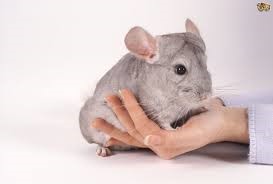
For most chinchillas, the easiest way to catch them is to scoop them up with both hands. To do this approach the chinchilla from in front and below. Do not approach from above. Chinchillas are prey animals and feel that they are in danger when something approaches from above them. Instead, the hands should slide, side by side, beneath the chinchilla from front to back. Once under, the chinchilla can be lifted and brought out of the cage to the chest in order to be held. Some chinchillas are afraid of being picked up either because they have been mistreated or not socialized. These chinchillas will probably jump out of the hands when this method is used. Frequent, calm attempts may teach these chinchillas that they will not be hurt. If the chinchilla tends to jump, the fingers can be used to grab the base of the tail to prevent jumping.
The tail grab looks cruel when in actuality, it is quite painless and can be less traumatic for most chinchillas. One must be careful, however, to be sure to do it correctly. If not, serious injury including a broken or de-gloved tail, can be the result. When done properly, the tail grab or hold is painless for the chinchilla.
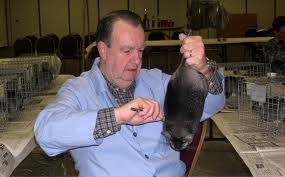
To appropriately grab a chinchilla by the tail, reach behind the animal and gently but firmly grab the tail by the base. This should be done as close to the body as possible. Once the tail has been grabbed, the other hand can be slipped under the chinchilla to pick it up. If that is not possible, the chinchilla can be gently lifted by the tail until support can be given to the feet. Never swing the chinchilla by the tail.
The tail grab can also be used to hold a chinchilla while grooming. To do this, the groomer holds the tail and lifts the chinchilla up. The entire tail is used to prevent excess stress on any part of it. The groomer then quickly grooms the chinchilla and sets it in his lap when he is finished. Many groomers will work in short sessions to give the chinchilla a break from hanging upside-down.
With few exceptions, the more often chinchillas are handled, the tamer they become. Of course, chinchillas that have been neglected, abused and/or traumatized sometime in their lives may never be comfortable with being held. It is necessary, however, to handle them. They do need to learn to tolerate being handled. This is needed in case the chinchilla should become ill or injured. A chin that cannot tolerate being handled will be immensely more traumatized by a trip to the vet than it would be if it was used to being held.
That being said, the average chinchilla should be handled on a daily basis. Just a few minutes a day is all it takes to keep a chinchilla tame and friendly.
Special Note: It does not traumatize a chinchilla to just reach in and pick it up. The philosophy of waiting until the chinchilla comes to you has a major flaw. There are a number of chinchillas that will never come to a hand, therefore these animals will never get the chance to learn what it feels like to be held by a loving person. These chinchillas need to be picked up against their will and handled calmly and kindly so they can learn to tolerate or even like being held. Giving them a cheerio while holding them will help them associate good things with being handled.
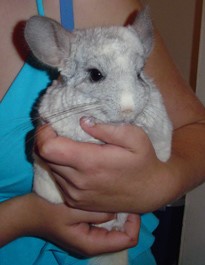
Many breeders believe that children under twelve years of age should never be allowed to handle chinchillas because they might panic and hold the chinchilla too tightly thus injuring it. This idea is controversial. Many other breeders believe that most children between the age of two and twelve can be taught how to handle chinchillas without harming them. Al children should be taught how to respectfully and safely treat any animal. The sooner they learn, the better.
The proper way for a child to hold a chinchilla is to have the child sit down on the floor or a sofa. Place the chinchilla in the child’s arms so that all four feet are supported. Do not let go of the chinchilla until it stops wiggling. Stay with the child while they are holding the chinchilla. Never leave young children and chinchillas unsupervised. Anything can and will happen. While being supervised, the child can be shown how to gently hold the chinchilla by putting their hands around it and even petting it. Teach the child to let go if the chinchilla tries to get away. It is much easier to catch a loose chin than to mend a broken heart if the child clamps down and injures the chinchilla. With older children, they can be taught how to hold on to the base of the tail to prevent escapes. Never allow a young child to get the chinchilla out of the cage. Chinchillas can be very unpredictable and can either escape, get injured or injure the child by biting. An adult or older experienced child should be in charge of removing the chinchilla or catching it if it gets loose.



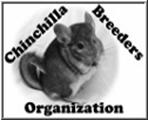 Site Last Updated on December 31, 1969 05:00 pm
Site Last Updated on December 31, 1969 05:00 pm